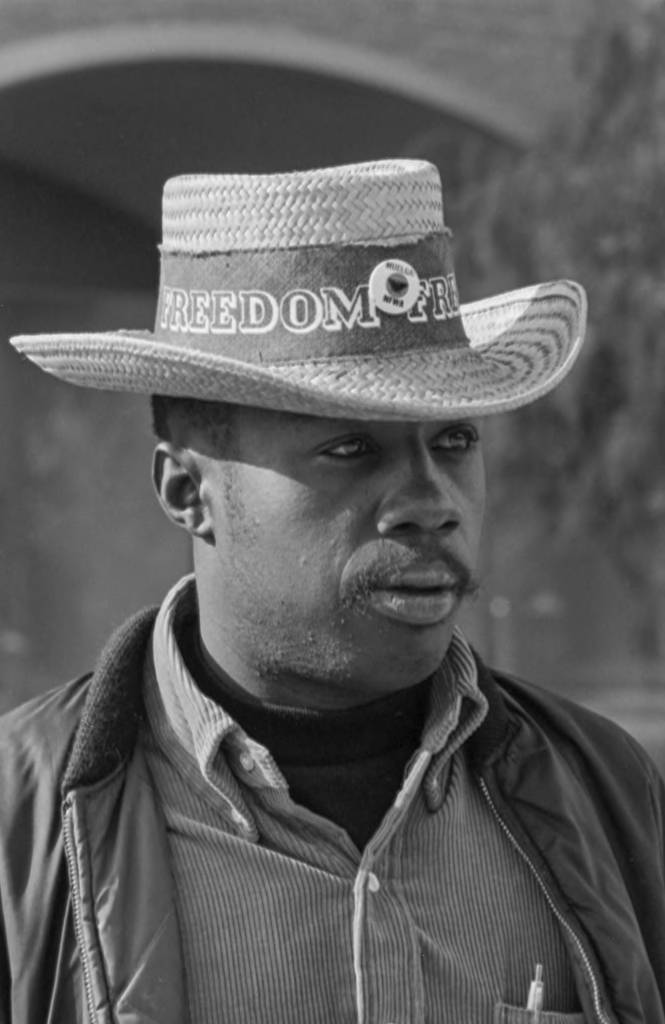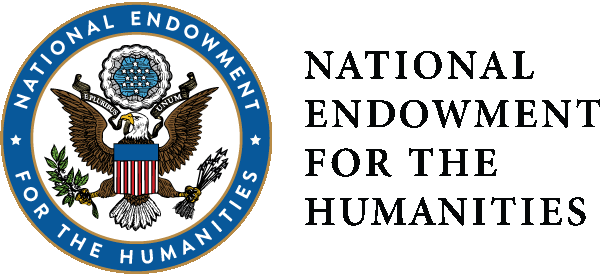Alliance with Black Panther Party
Alliance with Black Panther Party
UFWOC supporter from the Black Power movement picketing in front of a store, California, 1966. Photo by Emmon Clarke.
The story of the alliance between the farmworker movement and the Black Panther Party (BPP) is usually told as if it started in 1968 with the grape boycott. Emmon Clarke’s series of photographs taken in late 1966 shows that the Black Power movement picketed for farmworkers at this time—the BPP was established in October of 1966.
UFWOC supporter from the Black Power movement picketing in front of a store, California, 1966. Photo by Emmon Clarke.
The UFWOC launched in 1968 a nationwide boycott of all California table grapes, and the Panthers joined the farm workers’ striking efforts by banning the consumption of Bitter Dog, the official drink of the BBP. This UFWOC-BPP alliance got stronger in 1969 when the UFWOC launched a boycott against Safeway, the second-largest buyer of California grapes in the U.S., and the Panthers joined it.
UFWOC supporter from the Black Power Movement attending a boycott, California, 1966
This photograph depicts a supporter of the Farmworker Movement standing next to a store where picketers are organizing a boycott. He is wearing a straw hat. On the hat is a cloth band with the word “FREEDOM” written around it and the typical button with the symbolic black eagle and the words, “Huelga NFWA.” Captured in late 1966 in California, the image establishes a connection between these events and those unfolding in Mississippi during the Civil Rights Movement.
This hat, we discovered, is the same hat some of the marchers wore during the March Against Fear, a 220-mile walk during the period of the Civil Rights Movement led by activist James Meredith from Memphis, Tennessee, to Jackson, Mississippi, and it underscores the unity among diverse social movements. The Meredith’s March for Freedom started on June 5, 1966, when the civil rights activist decided to challenge Black voter suppression and racism. Meredith’s peaceful initiative in June of 1966 faced immediate brutality. On the second day, a sniper wounded him in the neck, head, and back. James Meredith had previously confronted hostility when he applied to the segregated University of Mississippi, triggering a legal battle that led to the admission of Black students; he faced protests and violent white riots from both state officials and residents.
Unable to continue the march he initiated, Meredith gained support from major civil rights groups. Martin Luther King and Floyd McKissick, the national director of the Congress of Racial Equality (CORE), met with Stokely Carmichael, Cleveland Sellers, and Stanley Wise from the Student Nonviolent Coordinating Committee (SNCC). They agreed to join forces and despite encountering harassment, intimidation, and local resistance, the groups successfully coordinated the three-week march. Recovering from his injuries, Meredith joined the march towards the end, when 15,000 marchers arrived at the Jackson finish line, contributing to the largest civil rights march in Mississippi.
Not only was Safeway buying its grapes from growers refusing to sign collective contracts with UFWOC, but it also refused to donate to the Panthers’ Free Breakfast for Children Program, a program that provided meals to school-age children and that depended on donations from local businesses. The UFWOC-BPP boycott forced Safeway on 27th and West streets in Oakland to close. The alliance between the two movements was not only local but also the BPP network helped the UFWOC nationwide.
UFWOC supporter from the Black Power movement picketing in front of a store, California, 1966. Photo by Emmon Clarke.
Gilbert Padilla remembers how the Black Panthers helped in Los Angeles and Philadelphia, and Eliseo Medina worked with the Panthers in Chicago. The support was reciprocal. When the Panthers were targeted by the FBI, the UFW rallied in defense of the party. And in 1973, while César Chávez was endorsing the Oakland mayoral campaign of Bobby Seale, the Panthers were marching with farm workers on the picket lines of a new UFW Safeway boycott.
Tom & Ethel Bradley Center
California State University, Northridge
18111 Nordhoff Street, Northridge, CA 91330
Phone: (818) 677-1200 / Contact Us


